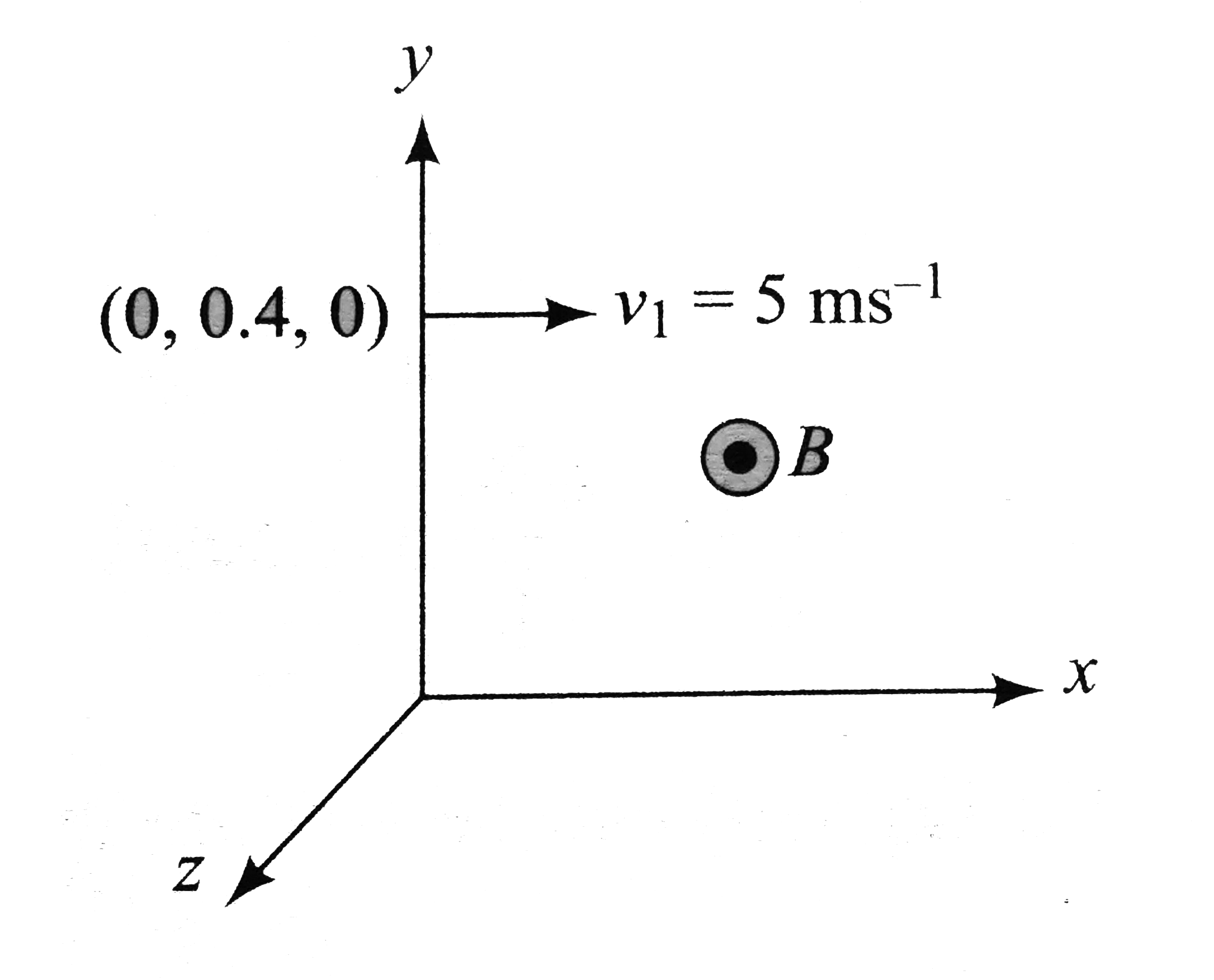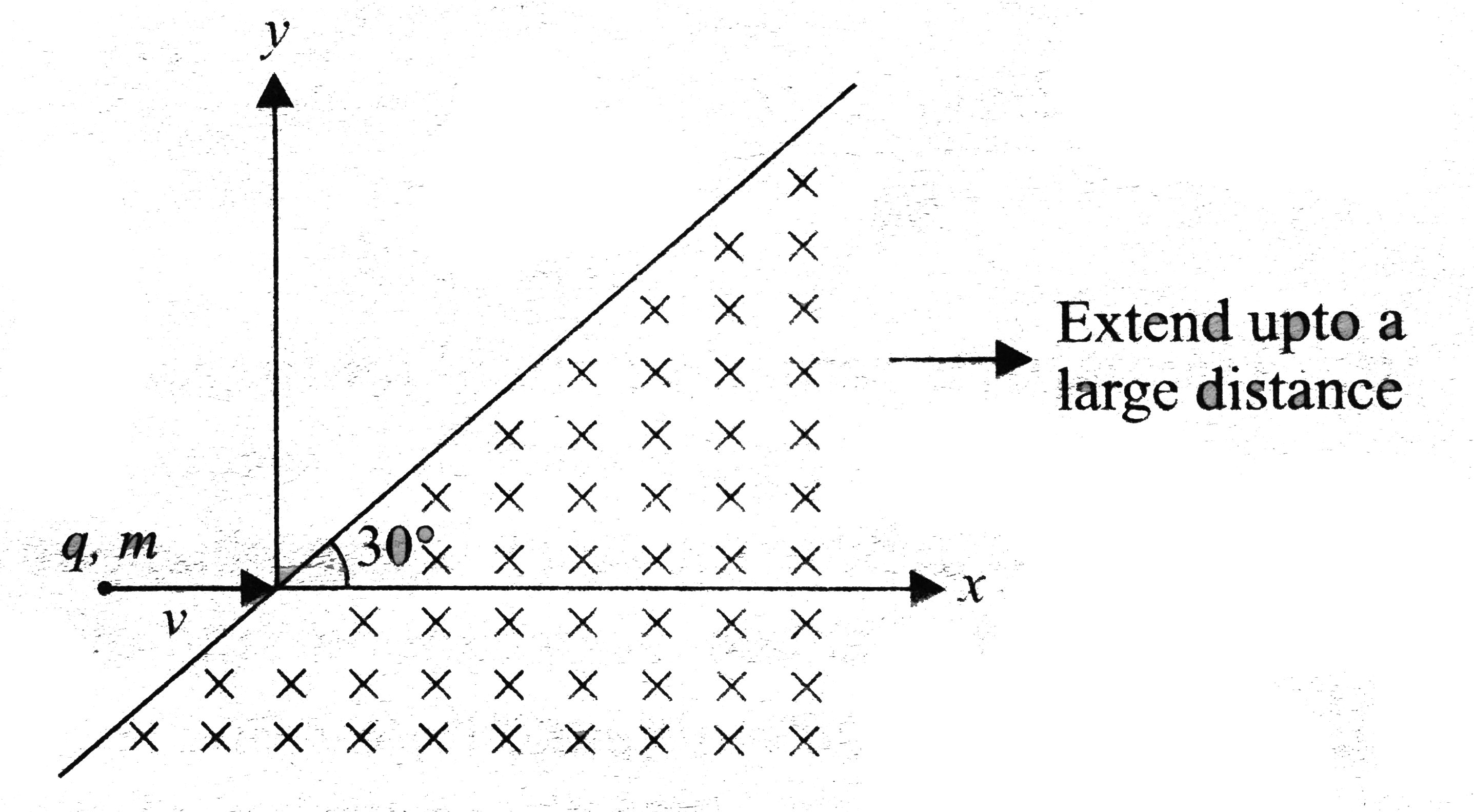A positively charged particle of charge 1C and mass 40g, is revolving along a circle, of radius 40cm with velocity 5ms in a uniform magnetic field with centre at origin 0 in xy-plane. At t=0, the particle was at (0,0.4m,0) and velocity was directed along positive x-direction. Another particle having charge 1C and mass 10g moving uniformly parallel to z-direction 40 with velocity 40πmscollides with revolving particle at t=0 andgets stuck with it. Neglecting 7C gravitational force and colombians force, calculate x,y and z-coordinates of the combined particle at t=π40sec
In three dimensional co-ordinate system, axes are assumed according to right hand screw rule.
Consider such a system shown in Fig. In this system positive z direction is normal to plane of paper and is directed towards the reader.
The particle is positively charged, centre of its circular path is at origin and when the particle is on positive y-axis , its velocity is directed along positive x-direction, it means that the particle is moving clockwise

Since the particle is positively charged, therefore, current associated with its motion is also clockwise or along positive x direction at (0,0.4,0).
Lorentz's force is toward origin. Therefore, according to Fleming's left hand rule, magnetic induction B must be along positive z-direction.
Radius of circular path followed by this particle is r1=0.4m
But r1=m1v1q1B⇒B=m1v1q1r10.5T
Now the second particle collides and gets struck with it. Velocity of combined particle can be found out by applying law of conservation of momentum.
(m1+m2)→v=m1→v1+m2→v2
(40×10−3+10×10−3)→v
=(40×10−3)×5ˆi+(10×10−3)40πˆk
∴ x-direction of velocity of combined particle is vx=4ms−1
and z-direction, vz=8πms−1
Due to vx, combined particle tries to move clockwise along a circular path and due to vzit ties to move uniformly along z-axis.
Therefore, its ultimate path becomes helix. Radius of this helix is
R=(m1+m2)vx(q1+q2)B=0.2m
and period of revolution T=2π(m1+m2)(q1+q2)B=π10s
The particle turns by angle π/2 in time π/4s.
∴ x-coordinate of new position of combined particle =R=0.2m
→ y-coordinate=r1−R=0.2m
and z-direction =vzt=0.2m
 .
.
Topper's Solved these Questions
- BOOK - CENGAGE PHYSICS ENGLISHCHAPTER - MAGNETIC FIELD AND MAGNETIC FORCESEXERCISE - Exercise 1.122videos
MAGNETIC FIELD AND MAGNETIC FORCES
- BOOK - CENGAGE PHYSICS ENGLISHCHAPTER - MAGNETIC FIELD AND MAGNETIC FORCESEXERCISE - Exercise 1.213videos
MAGNETIC FIELD AND MAGNETIC FORCES
- BOOK - CENGAGE PHYSICS ENGLISHCHAPTER - MAGNETIC FIELD AND MAGNETIC FORCESEXERCISE - Multiple Correct Answer type2videos
MAGNETIC FIELD AND MAGNETIC FORCES
- BOOK - CENGAGE PHYSICS ENGLISHCHAPTER - INDUCTANCEEXERCISE - Concept Based8videos
INDUCTANCE
- BOOK - CENGAGE PHYSICS ENGLISHCHAPTER - MISCELLANEOUS VOLUME 3EXERCISE - True and False3videos
MISCELLANEOUS VOLUME 3
Similar Questions
A positively charged particle having charge q1=1C and mass m1=40gm is revolving along a circle of radius R=40cm with velocity v1=5ms−1 in a uniform magnetic field with center of circle at origin O of a three-dimensional system. At t=0, the particle was at (0, 0.4m, 0) and velocity was directed along positive x direction. Another particle having charge q2=1C and mass m2=10g moving uniformly parallel to positive z-direction with velocity v2=40/πms−1 collides with revolving particle at t=0 and gets stuck to it. Neglecting gravitational force and coulomb force, calculate x-, y- and z-coordinates of the combined particle at t=π/40s.
View SolutionA charged particle of charge 1 mC and mass 2g is moving with a speed of 5m/s in a uniform magnetic field of 0.5 tesla. Find the maximum acceleration of the charged particle
View SolutionA charged particle of charge 1 mC and mass 2g is moving with a speed of 5m/s in a uniform magnetic field of 0.5 tesla. Find the maximum acceleration of the charged particle
View SolutionA charge particle of charge q and mass m is moving with velocity v as shown in fig In a uniform magnetic field B along -ve z-direction.Select the correct alternative (s).
 View Solution
View SolutionA particle of charge 1μC& mass 1g moving with a velocity of 4m/s is subjected to a uniform electric field of magnitude 300Vm for 10sec. Then it's final speed cannot be :
View SolutionA charged particle of mass m is moving with a speed u in a circle of radius r. If the magnetic field induction at the centre is B, the charge on the particle is
View SolutionA charged particle of mass m and charge q is released from rest the position (x0,0) in a uniform electric field E0ˆj. The angular momentum of the particle about origin.
View SolutionA particle having a charge20μC and mass 20μg moves along a circle of radius 5.0 cm under the action of a magnetic field 5.0 cm under the action of a magnetic field B = 1.0 T. When the particle is at a point P, a uniform electric field is switched on and it is found that the particla continues on the tangent through P qith a uniform velocity. Find the electric field.
View SolutionA charged particle of specific charge (i.e.,Charge per unit mass 0 0.2 C/kg has velocity 2ˆi−3ˆjms−1 at some instant in a uniform magnetic field 5ˆi+2ˆj (tesla).Find the acceleration of the particle at this instant
View SolutionA particle having a charge of 10.0μC and mass 1μg moves in a circle of radius 10 cm under the influence of a magnetic field of induction 0.1T. When the particle is at a point P, a uniform electric field is switched on so that the particle starts moving along the tangent with a uniform velocity. The electric field is
 View Solution
View Solution
